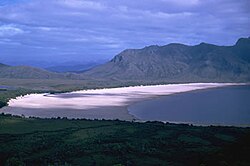| Lake Pedder planarian | |
|---|---|
| Scientific classification | |
| Kingdom: | Animalia |
| Phylum: | Platyhelminthes |
| Order: | Tricladida |
| Family: | Dugesiidae |
| Genus: | Romankenkius |
| Species: | R. pedderensis |
| Binomial name | |
| Romankenkius pedderensis Ball, 1974 | |
The Lake Pedder planarian (Romankenkius pedderensis) is a species of invertebrate in the family Dugesiidae. [2] This species was gregarious within the aquatic community of the lake before it flooded, living alongside small fish and invertebrates such as the Pedder galaxias and Lake Pedder earthworm. [3]

